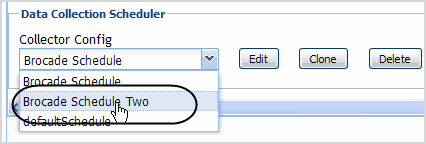Creating a unique schedule for an agent
|
1 |
From the Agent Status view, click Modify the private properties for this agent. |
|
5 |
Click Edit. |
|
7 |
Click Save Changes to update the new schedule. |
|
8 |
Close the Storage Collector-<name> dialog box. |
|
9 |
Click Save to assign the new schedule to the agent. |
|
10 |
Click Back to Agent Status. |
Assigning a Cloned Schedule to Another Agent
This procedure provides the steps required to clone a schedule to another Storage Collector agent.
|
1 |
From the Agent Status view, click Modify the private properties for this agent. |
|
3 |
Click the Collector Config drop-down list. |
|
5 |
Click Save to assign this new schedule to this agent. |
|
6 |
Click Back to Agent Status. |
Managing Foglight for Storage Management Rules
|
NOTE: You require the Foglight for Storage Management role Administrator to perform tasks that affect rules. |
To see the list of Foglight for Storage Management rules, navigate to Administration > Rules & Notifications > Rule Management, and select StorageUI from the Cartridge list. For help with rules, open the online help from this dashboard.
All Foglight for Storage Management rule names start with StSAN and are organized into categories:
|
• |
Essential—StSAN E—Essential rules alert on latency issues, capacity issues, device failures, and errors. |
|
• |
Normal—StSAN N—Normal rules alert on things like data traffic spikes. |
|
• |
Tuning—StSAN T—Tuning rules are additional rules for situations that do not cause performance issues in most environment. |
The Essential and Normal categories are enabled by default. The rules within each category can be enabled or disabled individually. By default, all rules in the Essential category are enabled, and all rules in the Normal category are disabled. You may want to review the Normal rules and enable the ones that suit your environment. Finally, you can control whether alarms are generated for rules in all categories or only some categories. For more information, see Changing Alarm Sensitivity.
|
NOTE: Rules that begin with StSANCar are rules used internally by the Storage cartridge, and do not generate alarms. Do not disable or alter these rules. |
Managing Alarm Settings
You can control which type of rule generates alarms and also set up email notifications.



